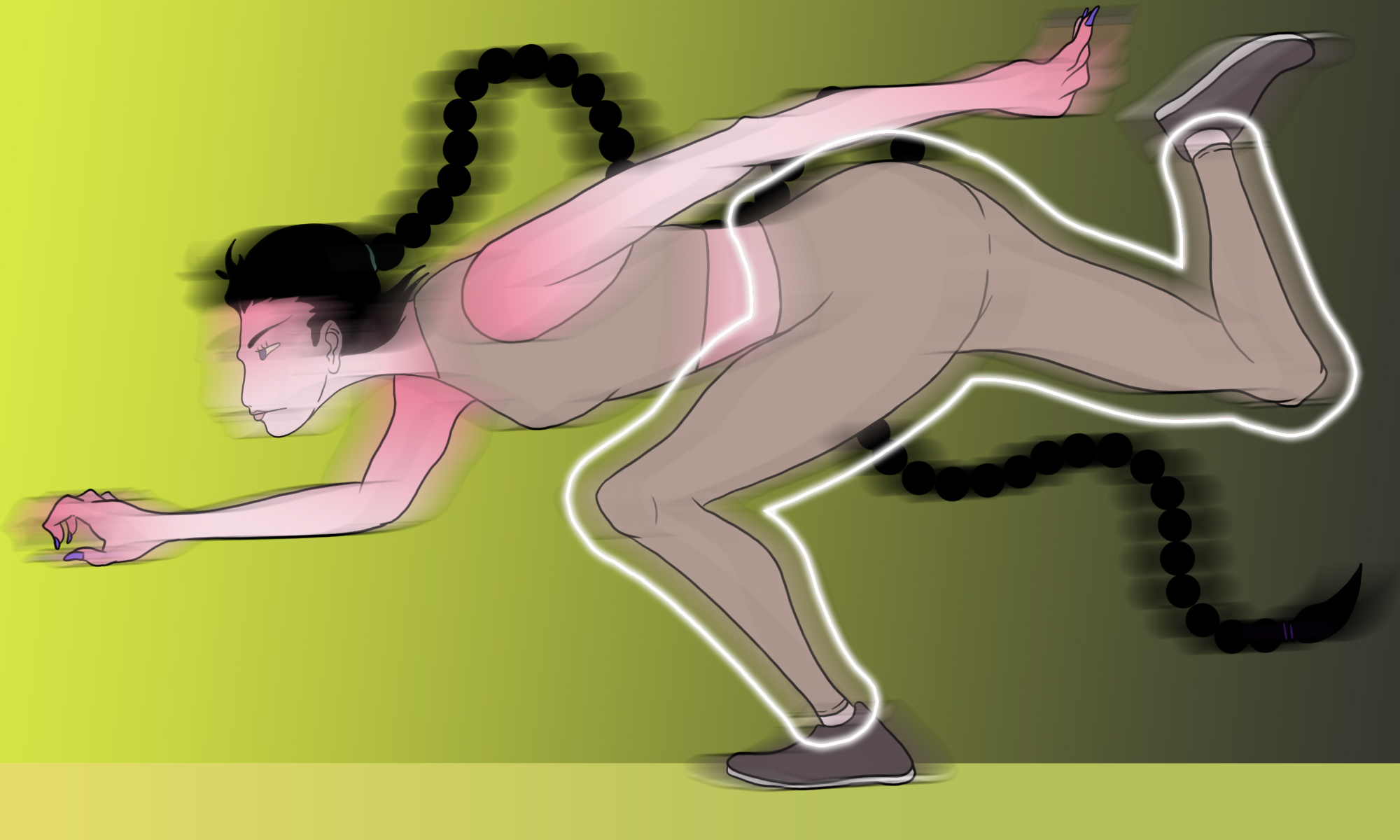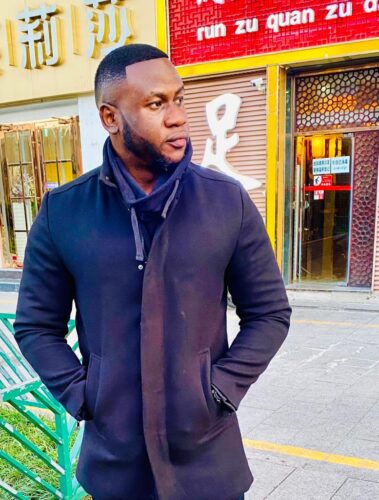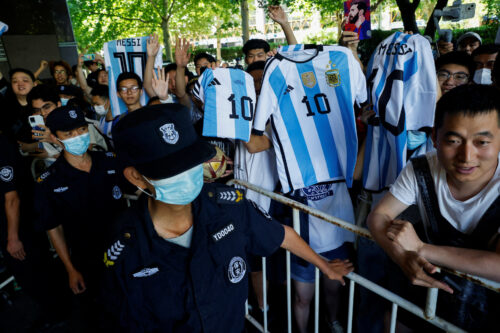Will skintight leggings trend outlast China’s body-shaming critics?
It’s been more than five years since Canadian athleisure brand Lululemon, known for its yoga pants, entered the Chinese market. But one specific product — workout leggings — never took off until this summer…alongside the rise of an alternative sport.

Lucia Han, a 32-year-old marketing and social media strategist living in Shanghai, has a complicated relationship with leggings. Since she bought her first pair while studying abroad in the UK, the body-hugging, form-fitting pants never left her wardrobe. In Shanghai, Han, who describes herself to The China Project as an “ultra-active person leading a healthy lifestyle,” dons leggings to her small group yoga and Pilates classes every week.
But her love for the athleisure garment has a limit. As much as Han wants to enjoy the comfort of leggings wherever she goes, the young professional finds herself reluctant to be seen in those stretchy pants in public. “When I returned to China in 2015, I had this reverse culture shock when I walked down the street in my leggings, receiving uncomfortable, judgmental stares from strangers,” she recalled. “My female friends had to explain to me that leggings weren’t a ‘thing’ in China and it was inappropriate to wear them outside home.”
Fast-forward a couple years later, and leggings are suddenly all the rage among Chinese women in the summer of 2022. But contrary to what you might have guessed, their rise to post-pandemic stardom isn’t the result of some high-profile celebrities’ endorsement or a viral marketing campaign by legging empire Lululemon. Rather, all it takes for this item of clothing to become trendy — as it turned out — is a niche sport to go mainstream.
A fashion staple in China’s newest sports fad
A tiny crop tank highlighting the small waist. High-rise leggings showing off the curves. A pair of sneakers and sometimes a baseball cap. Combined, that’s the highly coveted look of a stylish, athletic girl at the moment, particularly in affluent cities like Beijing and Shanghai. The outfit’s ground zero are soccer fields across the country, where packs of attractive, fit young professionals can be spotted tossing around a flying disc on multiple nights of the week.
The sport they play is Ultimate Frisbee, which in Chinese has been given the literal translation of jíxiàn fēipán 极限飞盘. First invented in 1968 by a group of students at a U.S. high school, Ultimate Frisbee is a hybrid sport that combines parts of soccer, basketball, and football — but played with a flying disc. As a non-contact, self-refereed game, Ultimate runs on one essential element called “Spirit of the Game,” an overarching principle that encourages fair play, sportsmanship, and fun above competition.
It took a while for Ultimate to reach China. When it finally did in the late-’90s / early-2000s, most participants were expatriates. But in the past year, as the pandemic-fatigued, outdoor-obsessed Chinese youth looked for new ways to socialize and stay healthy, Ultimate Frisbee emerged as a trendy outdoor activity and a bona fide cultural phenomenon, along with camping and cycling.

Sheer novelty is what drew Nora, a 25-year-old fashion designer in Beijing, to Ultimate Frisbee. An early adopter of many lifestyle fads, Nora was in search of something new to have fun with when posts of good-looking influencers — often dressed in a chic athleisure outfit characterized by a pair of leggings — playing Ultimate started to take over her feed on Little Red Book, Nora’s favorite app to use to keep up with current trends or discover new brands. Eager to be part of the trend, Nora bought her first pair of leggings from Maia Active, a Shanghai-based, female-focused sportswear brand, and reached out to a local club.
It took Nora several practices to learn how to play the sport properly, but she said she was hooked after her first game and kept at it. Having now played regularly, mostly twice a week, since June, Nora said she had improved tremendously. “I feel pretty good about myself going out there. The atmosphere is cool and I love everyone’s style,” Nora said.
The “style” she was referring to is a specific look. When on the field, Nora noticed that most female players, including herself, sport near-identical outfits, with leggings being the centerpiece. “It’s definitely a trend,” Nora said of the prevalence of leggings at Ultimate games. But more than making a fashion statement, there are practical reasons to wear leggings too, she added. “Compared to traditional athletic pants, leggings give me strong support and flexibility to help me move around with ease. I also tried sports shorts before, but they kept riding up and it annoyed me.”
Now a total convert to leggings, Nora just bought her fifth pair, an exuberantly patterned version from Lululemon, which she said feels “as soft and light as” her second skin. And she’s trying to incorporate the tight-fitting garment more into her everyday wear, outside workout settings. “I’ve seen photos of celebrities like Hailey Bieber pairing high-waist leggings with an outsized blazer and a sports bra. That’s a look I can see myself in when the temperature drops.”
The next capital darling?
For many Chinese women like Nora, this second-skin style has become trendy not only for throwing flying discs, but for lounging, brunching, and most any other nonathletic activity one can imagine. On Little Red Book, styling tips surrounding leggings have taken the app by storm in the past few months, with some fashion bloggers declaring them “the must-have item this summer.”

As leggings hit mainstream fashion hard this year, brands and investors took notice. In May, the Chinese fitness apparel brand COCOFIT announced the completion of an angel round financing worth more than 10 million yuan ($1.48 million), led by Beijing-based venture capital firm K2VC. Founded in 2021, COCOFIT has attracted a solid following for its high-tech exercise leggings made of innovative fabric, the brand’s best-selling item across all Chinese ecommerce sites.
“COCOFIT chose to build its business around leggings because it believes that there’s a huge market for this type of product in China. Plus, the space for domestic brands focusing on athleisure wear hasn’t been saturated yet,” 36Kr, an online business news portal, wrote in an article analyzing the start-up’s appeal to investors. “It has potential to become a well-known brand just by conquering the leggings market.”
Previously, in April, Chinese athleisure clothing brand Jmap 焦玛 secured a funding round of over 10 million yuan ($1.5 million), backed by two Chinese firms, ShareLink Investment and Qianfan Mingyue Capital. Launched earlier this year with a line of seamless, ultra-flattering leggings, Jmap prides itself on sensibly-priced, quality leggings that come in a variety of colors, which gives customers the ability to style them for different occasions.

But even as Chinese newcomers are set to take market share, quintessential legging retailer Lululemon is still primed to be the biggest beneficiary of the ongoing leggings fad, thanks to the customer base it has developed over the years.
In 2016, as traditional sportswear giants like Nike and Under Armor stepped up their offerings for the yoga-mat-toting demographic, causing Lululemon’s sales to slide in the U.S. and Europe, the Canadian brand set its sights on China and opened its first store there. Six years later, the premium sportswear market now operates more than 80 locations across the country, with its physical reach expanding into second- and third-tier cities like Nanning and Ningbo for the first time last year.
While Chinese athleisure labels tend to stand above their foreign competitors in terms of affordability, the relatively high prices for Lululemon’s leggings — they retail for around 1,000 yuan ($147), at least double to triple the price of similar products from Chinese brands — are justified in the eyes of its devoted fans. “The style and comfortability of Lululemon’s leggings are unbeatable,” Nora said. But to Lucia, she sees Lululemon more of a “lifestyle” brand whose values align with her own. A frequent participant in yoga and wellness events organized by Lululemon, Lucia said that she thinks of the brand as an embodiment of “healthful living, mindfulness and female empowerment.” “It really offers a sense of community, which is something I’m willing to pay extra for,” she added.
Although Lululemon suffered what Reuters described as a modest impact from COVID-19 lockdowns in China on its stores and some vendors, the premium sportswear maker remains optimistic about its future. Last month, in an exclusive interview with China Daily, Lululemon CEO Calvin McDonald revealed that the company expects China to become its second-largest market worldwide by 2026 “through new store openings, an expanding product portfolio and enhanced omnichannel community engagement.”
In defiance of gendered clothing shaming
As leggings’ popularity boomed, so did the backlash against it. The complaints about the garment first emerged in the circle of Ultimate Frisbee, where long-time players accused leggings-donning newcomers of commodifying and sexualizing the game, causing it to have a “bad rap” as a fleeting fashion trend rather than a serious, competitive sport. The concept of good-looking influencers who only play Ultimate to flaunt their curves in form-fitting attires for social media clout even has a name: fēipányuán飞盘媛, which can be roughly translated as “female frisbee socialite” in English.
Nora, who regularly shares photos of her playing Ultimate in full makeup and carefully coordinated outfits on social media, said that she has been called feipanyuan many times on the internet. Tired of being “labeled unfairly,” she said, Nora published a rebuttal on Little Red Book last month. “I’ve met people who came to a game but never actually played. They posed for photos for 30 minutes and left,” she wrote. “But they didn’t get in my way of playing, so there was no reason for me to get riled up.”

“There’s this stereotype that women shouldn’t wear makeup or pay attention to their appearance in general when they play sports. This is totally nonsense,” she said to The China Project. “As more and more women partake in Ultimate, it’s completely normal for them to take photos of themselves on the field as a way to document the experience. I want to look good while playing Ultimate. It makes me happy, so why would I stop doing that?”
As leggings slowly but steadily transcends Ultimate fields and fitness studios to become an everyday garment, the debate about its appropriateness has also entered the sphere of public discourse. Naysayers of the trend argue that leggings are a symbol of slipping standards and deviation from modesty, which is considered a virtue for women in traditional Chinese culture. “I don’t mean to infringe on anyone’s right to dress freely, but it’s really inappropriate to show the shape of your butt in public,” read a comment on a WeChat article discussing the trend.
On the other side, legging lovers urge the critics to cut the shaming and stop policing their bodies. Under the aforementioned WeChat article, an incensed legging wearer wrote, “Leggings are such an unexpected source of controversy! Do people know that it’s everyday wear in other parts of the world, for women of all sizes?”
Meanwhile, Lucia recently started wearing the garment outside her yoga and Pilates classes. “I see lots of overheated men rolling up their shirts or going completely topless in public these days. They are allowed to do that, but for some reason I’m being judged for wearing leggings? I’m not revealing anything!” Lucia said, referring to the “Beijing Bikini,” a longstanding summer practice that was banned in some Chinese cities for being “uncivilized,”, but still exists in other parts of the country.
At this point, Lucia said she basically “lives in” her 16 pairs of leggings. But she admits that the garment isn’t for everyone. When she recommended leggings to some friends in her hometown in Jinan who “tend to dress conservatively,” the idea got shot down immediately. “It’s their freedom and I respect that,” she said.






